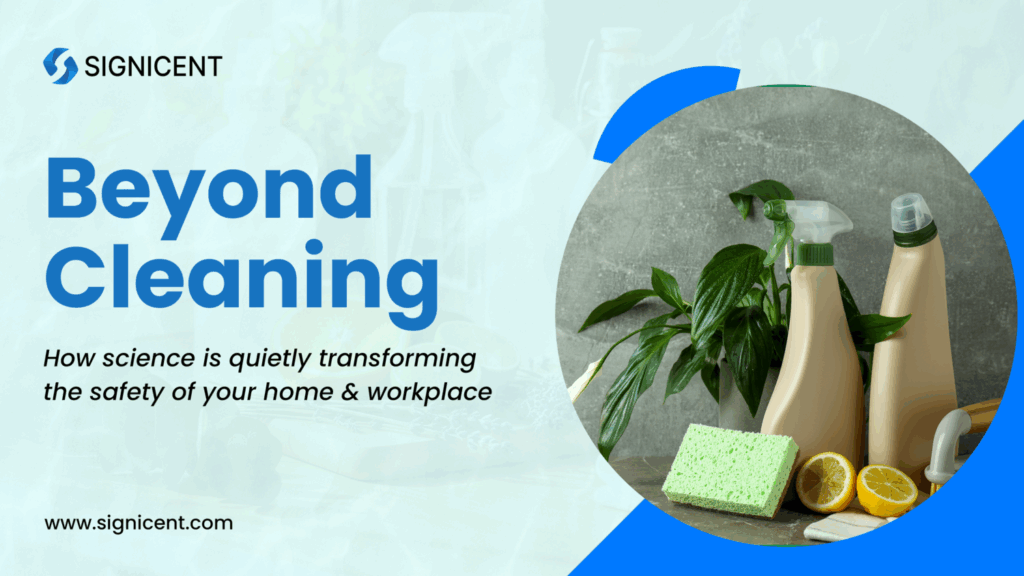Introduction – Why Hygiene Matters More Than Ever
In the present day living, hygiene has become a critical foundation for a healthy and safe life. From our homes and kitchens to workplaces and shared public spaces, the need for reliable antiviral technologies and advanced antibacterial technologies is stronger than ever. Moreover, the lessons learnt from the COVID-19 pandemic and other viral outbreaks have made it clear—quick cleaning is no longer enough. We now require long‑lasting hygiene innovations that provide continuous protection, keeping our environments safe well beyond the moment of cleaning.
From pandemic-driven demand surges to evolving pathogens like drug-resistant bacteria and new viral strains, the stakes have never been higher for brands in the personal and home care industry. And in this race to innovate, next-generation antibacterial and antiviral technologies are leading the way.
As a result, both consumers and industries are seeking more than just powerful cleaning products. Instead, there is a growing preference for natural disinfectants and eco-friendly germ protection solutions that are not only effective but also safe and sustainable. However, businesses must address these evolving needs while navigating strict global health regulations. In this blog, we explore how next‑generation antiviral and antibacterial solutions—identified through strategic technology scouting—are shaping a cleaner, safer, and more sustainable future for homes, industries, and communities worldwide.
What Are Antiviral and Antibacterial Technologies?
Have you ever wondered how certain products can protect you from harmful germs long after you’ve used them? Antiviral technologies are designed to inactivate or destroy viruses, while antibacterial technologies target and kill bacteria. These advanced solutions go far beyond traditional cleaning methods by offering continuous germ protection for hours, days, or even weeks.
From natural disinfectants infused with plant‑based ingredients to next‑generation hygiene innovations like silver nanoparticles, copper coatings, and enzyme‑based cleaners, these technologies are transforming how we safeguard our health—at home, in workplaces, and across industries. Understanding what they are and how they work is the first step toward creating cleaner, safer environments for everyone.
Why Choose Antiviral & Antibacterial Technologies Over Traditional Quats?
These days, health-conscious people and businesses who are ahead of the curve are changing the way they think about cleanliness. Traditionally, quaternary ammonium compounds (quats) have been a standard in disinfectants for decades. Yet, their drawbacks—such as potential skin irritation, toxic residue, and environmental impact—are driving demand for safer, more sustainable alternatives. Advanced methods like Biological Sequence Search are now being used to identify and screen naturally derived compounds with antimicrobial properties, offering promising, eco-friendly replacements.
In contrast, next-generation antiviral technologies and advanced antibacterial technologies deliver the same germ-killing power but with far greater benefits:
- Long‑Lasting Efficacy – Many modern solutions continue protecting for hours or even days after application, unlike quats that stop working soon after drying.
- Natural Alternatives – Plant‑based and biodegradable disinfectants reduce exposure to harsh chemicals while maintaining strong germ‑fighting ability.
- Eco‑Friendly Impact– Sustainable formulations minimise harm to the environment, aligning with green living and corporate responsibility goals.
- Regulatory Confidence– These innovations meet strict global health regulations, helping businesses make approved hygiene claims with confidence.
By switching from quats to natural disinfectants and long‑lasting hygiene innovations, companies and households gain effective germ protection without compromising on health, safety, or sustainability.

Challenges with Quats in Today’s Hygiene Landscape
However, while quaternary ammonium compounds (quats) remain common in disinfectants, their limitations are becoming increasingly clear. As a result, natural disinfectants and long‑lasting hygiene innovations are emerging as a smarter and safer alternative.
- Short‑Term Protection – Quats offer limited protection compared to antiviral technologies. Consequently, they require repeated applications, whereas, in contrast, long‑lasting hygiene innovations continue defending surfaces for days.
- Health Concerns – Prolonged exposure to quats may trigger skin irritation or respiratory issues. On the other hand, natural disinfectants provide gentler and safer antibacterial technologies that are ideal for daily use.
- Environmental Impact – Quats are not eco-friendly, contributing to pollution. Meanwhile, sustainable antibacterial technologies support greener living and reduce harmful chemical discharge.
- Regulatory Limitations – Strict compliance rules limit quat claims. Nevertheless, antiviral technologies meet global standards, strengthening brand trust and enabling confident hygiene marketing.
- Reduced Effectiveness – Quats may lose potency against evolving pathogens. Therefore, innovative antibacterial technologies adapt better to deliver lasting germ protection in changing environments..
Comparing Quats and Natural Disinfectants – The 6 Key Factors
When choosing between quaternary ammonium compounds (quats) and natural disinfectants powered by antiviral & antibacterial technologies, these six factors make the biggest difference for both performance and sustainability.
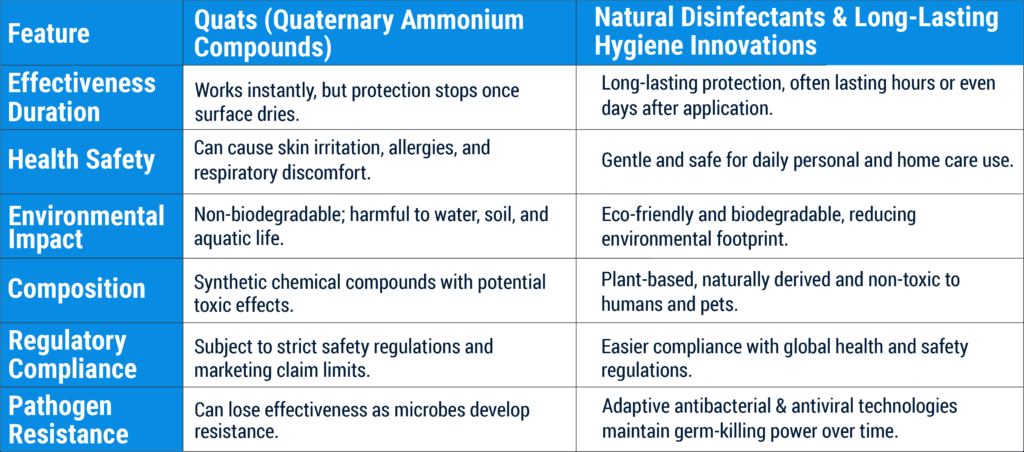
Natural Solutions That Can Replace Quats in Daily Life
Replacing quaternary ammonium compounds (quats) with natural disinfectants is now easier than ever, thanks to innovations in antiviral and antibacterial technologies. These plant‑based, and mineral‑derived alternatives are safe, effective, and ideal for everyday use in homes, offices, and healthcare settings. However, before introducing such solutions into the market, ensuring Freedom to Operate (FTO) is crucial — helping companies avoid infringement risks while bringing innovative and compliant products to consumers.
Here are some proven quat‑free solutions making an impact in daily life:
- Vinegar (Acetic Acid) – A natural cleaning agent effective against bacteria and viruses, ideal for kitchen surfaces, glass cleaning, and limescale removal.
- Hydrogen Peroxide – Eco‑friendly disinfectant that kills a broad range of microbes without toxic residues; perfect for bathroom and laundry use.
- Essential Oils (Tea Tree, Eucalyptus, Clove, Thyme) – Naturally antimicrobial; used in multi‑purpose sprays, hand sanitisers, and air fresheners.
- Citric Acid (from Citrus Fruits) – Breaks down grease, removes stains, and has mild antibacterial properties; safe for food contact surfaces.
- Baking Soda (Sodium Bicarbonate) – Gentle abrasive cleaner that deodorizes and cleans, often paired with vinegar for powerful home cleaning.
- Silver or Copper Nanoparticles – Naturally occurring minerals with antiviral and antibacterial action; used in fabrics, water filters, and surface coatings.
- Enzyme‑Based Cleaners – Break down organic matter naturally, ideal for pet messes, kitchen degreasing, and odor removal without harsh chemicals.
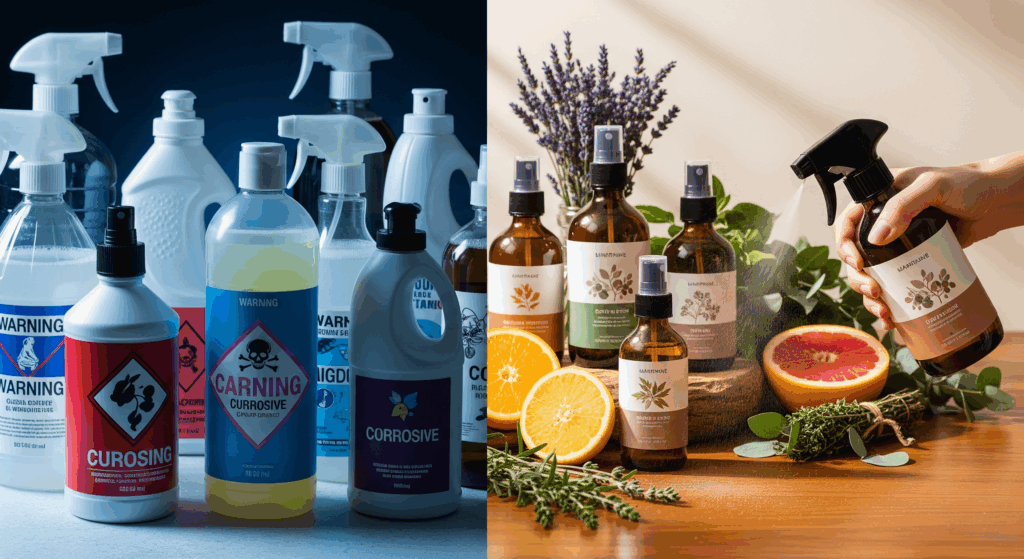
The Development of Hygiene Technologies: From Nature to the Next Generation
While natural quat‑free solutions are redefining daily cleaning, and science is taking hygiene protection even further. Cutting‑edge antibacterial technologies now work at the microscopic level, creating surfaces that actively resist germs and keep environments safer for longer. Organisations can use strategic tools like technology gap analysis to identify limits in existing solutions and expedite the adoption of next-generation antibacterial technology for improved hygiene and safety.
Next‑Gen Antibacterial Technologies – How They Keep Surfaces Safe
Modern antibacterial technologies are designed to do more than just clean — they actively stop bacteria from growing and keep surfaces protected for longer. Here’s how the most advanced ones work:
- Silver Nanoparticles (AgNPs) – Ultra‑small silver particles attach to bacteria, break their cell walls, and disrupt their vital functions, killing them effectively.
- Copper‑Infused Materials – Copper releases ions that destroy bacteria and viruses on contact, making surfaces self‑sanitizing without extra cleaning.
- Antimicrobial Coatings – Special coatings made with germ‑killing agents or natural plant extracts create a surface that prevents bacteria from multiplying.
These next‑generation antibacterial solutions give longer‑lasting protection than traditional cleaning methods, making homes, offices, and public spaces safer with less effort.
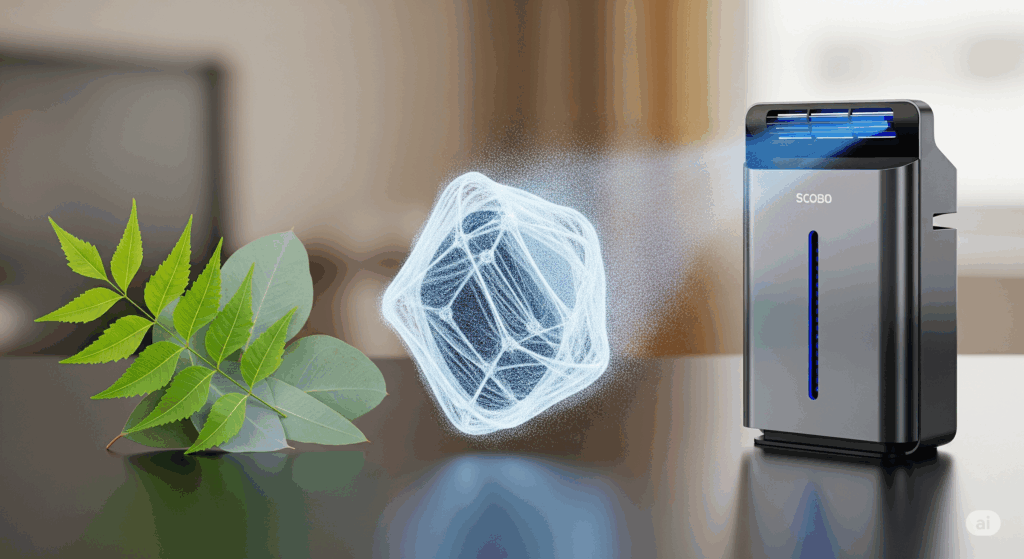
Advanced Antiviral Technologies – How They Work
While antibacterial solutions focus on bacteria, antiviral technologies are designed to neutralise viruses before they can infect. They deactivate or destroy virus particles, protecting people in busy environments where the risk of viral spread is high.
- Photocatalytic Coatings (TiO₂) – Activated by light, these coatings generate reactive oxygen species that break down viral proteins, rendering them harmless. Commonly used in air purifiers, wall coatings, and public transport interiors.
- Plant‑Based Viral Inhibitors – Extracts from neem, tea tree, and eucalyptus naturally block viruses from attaching to surfaces or cells, offering chemical‑free virus protection.
- Electrostatic Spraying Systems – Electrically charged disinfectant droplets wrap around all surfaces — even hidden ones — ensuring complete and uniform viral coverage.
By integrating these advanced antiviral technologies, industries and households gain fast‑acting, reliable virus defense that works proactively, not just reactively. This is the next step in sustainable, science‑driven hygiene.
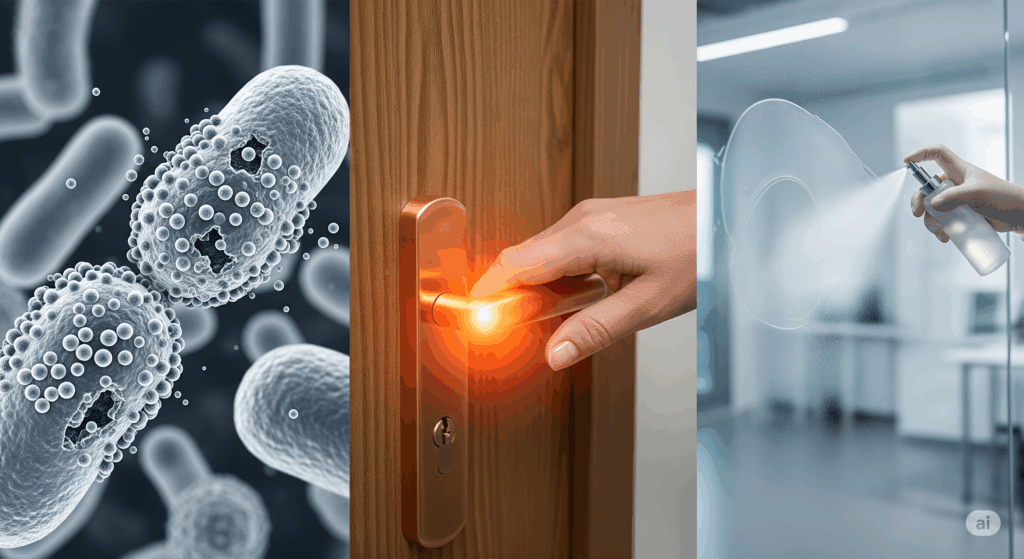
Smart Delivery Systems for Lasting Protection
Modern hygiene innovations are going beyond instant cleaning — they’re now designed to keep working for hours, days, or even weeks. These smart delivery systems ensure that antibacterial and antiviral agents are released gradually, giving long‑lasting germ protection without constant reapplication.
- Microencapsulation – Tiny microscopic shells encase active antibacterial or antiviral ingredients. These shells slowly break down, releasing germ‑killing agents over time. Commonly used in hand soaps, laundry detergents, and long‑lasting surface cleaners, this technology extends protection far beyond a single cleaning.
- Self‑Disinfecting Materials – Fabrics, plastics, and coatings infused with antimicrobial agents during manufacturing. These materials continuously kill bacteria and viruses on contact, making them ideal for hospital bed linens, reusable masks, and high‑touch public surfaces.
By adopting smart delivery systems, homes, businesses, and healthcare facilities gain 24/7 protection — reducing the need for frequent cleaning while maintaining a healthier, safer environment.
The Influence of Natural Products on Essential Aspects of Hygiene and Safety
By using plant-based, biodegradable, and eco-safe hygiene solutions, consumers and industries may address health, safety, and environmental concerns in a single step. To ensure these innovations are not only effective but also unique and legally sound, patent invalidity analysis plays a crucial role—helping companies validate their freedom to operate and protect their natural hygiene breakthroughs.
Here’s how natural hygiene innovations create a lasting impact:
- Long‑Term Germ Protection – Many natural solutions enhanced with antiviral technologies provide extended protection, safeguarding surfaces, fabrics, and personal spaces for hours or even days.
- Safe for Daily Use – Unlike harsh quats, natural antibacterial technologies protect without causing skin irritation or respiratory discomfort, making them ideal for regular contact.
- Environmentally Responsible – Plant‑based and biodegradable formulas reduce chemical waste, protect ecosystems, and align with global sustainability goals.
- Multi‑Surface Versatility – Suitable for homes, workplaces, healthcare settings, and even antimicrobial fabrics without causing material damage.
- Regulatory Friendly – Easier to comply with global health regulations, allowing brands to make credible hygiene claims and gain consumer trust.

Real-life applications with lasting impact from leading brands
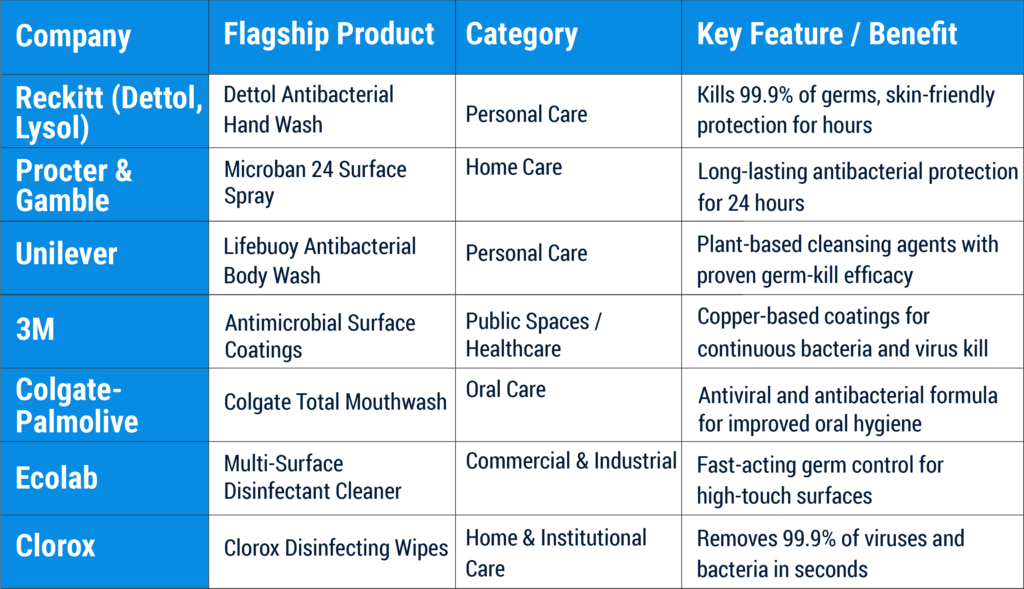
Market Outlook for Antibacterial & Antiviral Technologies
The antibacterial and antiviral technologies market is witnessing strong growth, driven by heightened hygiene awareness, post‑pandemic safety priorities, and demand for long‑lasting, eco‑friendly germ protection solutions. Advances in natural disinfectants, self‑disinfecting materials, and smart delivery systems are reshaping both the personal chttps://signicent.com/market-dynamics/are and home care segments.
According to Signicent Market Research, the global antibacterial and antiviral technologies sector is poised for significant expansion, as shown in the graph below. This growth is driven by rising hygiene awareness, the shift toward sustainable disinfectant innovations, and advancements in natural, eco‑friendly germ protection technologies.

This rising market presents immense opportunities for brands that embrace innovative, safe, and sustainable hygiene solutions. Therefore, companies that align with global sustainability goals while also meeting the growing consumer demand for reliable germ protection will, in turn, be best positioned to lead in this rapidly evolving sector.
- Increasing regulatory focus on safe, sustainable hygiene products
- Rising adoption of plant‑based, biodegradable disinfectants in consumer and industrial applications
- Integration of next‑gen coatings and nanotechnology in high‑touch surfaces and hygiene products
Leading Key Players
- Reckitt (Dettol, Lysol) – Expanding sustainable disinfectant ranges
- Procter & Gamble – Innovating in long‑lasting surface cleaners
- Unilever – Developing plant‑based hygiene products under global brands
- 3M – Leading in antimicrobial coatings for healthcare and transport
- Microban International – Specializing in built‑in antimicrobial protection for consumer goods and industrial products
- Ecolab – Commercial‑grade hygiene and disinfection solutions for food service, healthcare, and hospitality
- Clorox – Antiviral and antibacterial cleaning products for homes and institutions
Signicent supports antibacterial and antiviral technology leaders by delivering comprehensive technology landscape analysis covering natural disinfectants, antimicrobial coatings, self‑disinfecting materials, and smart delivery systems.
Our Patent Landscape analysis identifies innovation gaps and whitespace, helping clients align R&D strategies with sustainable hygiene trends. We actively scout emerging startups, evaluate breakthrough germ‑protection technologies, and uncover licensing and partnership opportunities to strengthen competitive positioning.
Additionally, we offer regulatory technology intelligence along with comprehensive market assessment and valuation to ensure alignment with global hygiene and safety standards. With Signicent’s strategic insights, clients can accelerate eco-friendly product innovation, respond effectively to growing market demands, and secure a sustainable competitive edge.
Future Outlook – Antibacterial & Antiviral Technologies in a Sustainable World
The future of antibacterial and antiviral technologies is set to move hand in hand with the world’s growing focus on sustainability, health, and safety. People, industries, and regulators are no longer satisfied with quick fixes — they want eco‑friendly hygiene solutions that deliver long‑lasting protection without harming the planet. This shift is paving the way for plant‑based disinfectants, biodegradable antimicrobial coatings, and self‑disinfecting materials to become the new standard.
Emerging breakthroughs in nanotechnology, smart delivery systems, and natural germ‑control agents will make it possible for homes, workplaces, and public spaces to stay protected with less chemical use and fewer cleaning cycles. These solutions won’t just kill germs — they’ll help create a cleaner, greener, and healthier future, where hygiene and sustainability work together seamlessly.
For forward‑thinking businesses, adopting these technologies early will mean standing out in the market, building deeper consumer trust, and staying in step with global environmental goals. The direction is clear: science‑driven, sustainable hygiene will lead the next chapter of public health protection.
FAQs on Antibacterial & Antiviral Technologies
1. What are antibacterial and antiviral technologies?
Antibacterial and antiviral technologies protect surfaces by eliminating harmful bacteria and viruses, offering sustainable, science‑driven hygiene solutions for homes, workplaces, and healthcare environments.
2. How are natural disinfectants different from chemical ones like quats?
In contrast, natural disinfectants use plant-based, biodegradable ingredients. As a result, they deliver safe and eco-friendly hygiene while avoiding harsh chemical exposure and preventing long-term environmental damage.
3. Do these technologies offer long‑lasting protection?
Yes, many antibacterial and antiviral technologies provide extended germ protection through smart delivery systems, reducing frequent cleaning needs and enhancing sustainable hygiene practices.
4. Are plant‑based solutions as effective as synthetic disinfectants?
High‑quality plant‑based solutions rival synthetic disinfectants, effectively eliminating germs while ensuring eco‑friendly hygiene, regulatory compliance, and safer daily use for people and the planet.
5. Which industries benefit most from these technologies?
Healthcare, hospitality, public transport, food service, and home care sectors benefit from antibacterial and antiviral technologies, ensuring reliable germ control and long‑lasting safety.
6. How can Signicent support businesses in this field?
Signicent provides market research, patent landscapes, and regulatory intelligence, helping companies develop innovative antibacterial and antiviral technologies for competitive, sustainable hygiene leadership.


